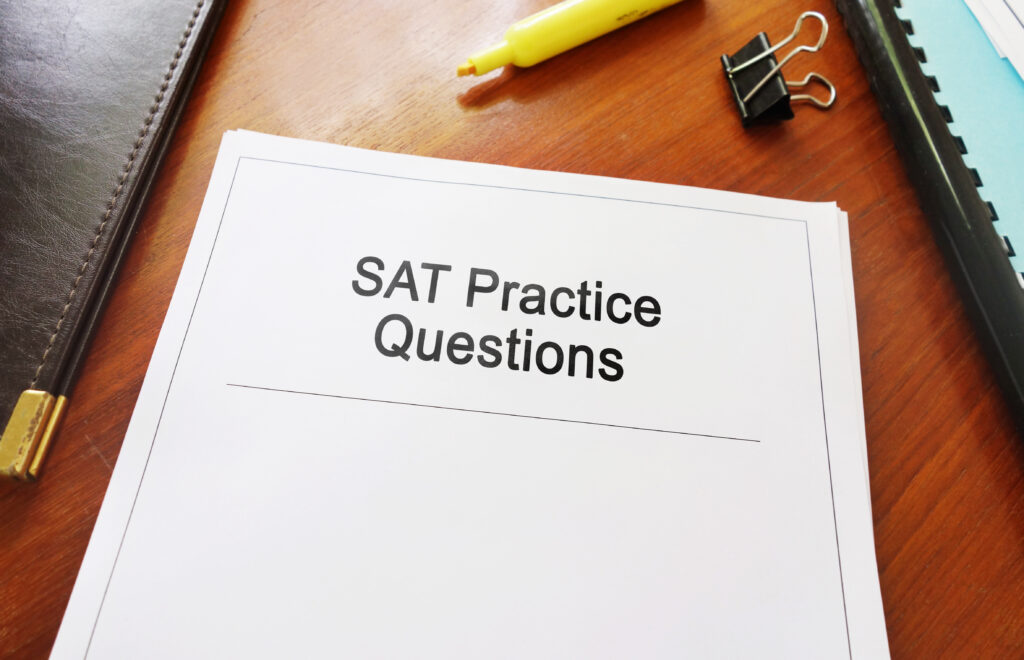Along with the rest of your high school class, you registered for the SAT or ACT last spring. Now, several long months later, the process of studying and sitting for your standardized test is finally done. The suspenseful wait for your results is over. And you’re ready for all of this to be behind you! But despite the obvious milestone, you’re sitting in front of your test score results email with mixed emotions.
In addition to a sense of completion, you have lingering doubts about how you could have scored if things were different. Did you choose the right test, after all? Can you convert your scores? And how?
Take heart; these questions are totally normal! And Empowerly is here to help clear the air. Understanding how SAT to ACT score conversion works is key for planning your next move in the college admissions process. Whether you’re aiming for scholarships, assessing your admissions competitiveness, or deciding if a retake is worth it, we’ll discuss your best options.
First, the basics: ACT vs. SAT
If you just tuned into the discussion, you might be confused by all the letters and acronyms that we’re throwing around. And with so many colleges going test-optional, you might wonder whether these exams even still matter — and if so, which one is right for you. If you’re new to this topic, let’s break it down. If you’re familiar with these terms already, go ahead and skip ahead to the next section about why you might want to convert your scores.
Fundamentally, both the ACT and SAT are academic college-readiness assessments that are administered on a national scale. In other words, two really big tests!
Why do they matter? Since individual school districts can vary so widely, these exams intend to provide college admissions departments with comprehensive quantitative information about prospective students’ performance on a more standardized scale.
Though imperfect when employed as standalone predictors of success in college, ACT and SAT scores remain a large part of the admissions process today.
What is the SAT?
The letters “SAT” used to stand for Scholastic Aptitude Test or Scholastic Achievement Test, but these days, officials say the name SAT signifies neither. Following a series of multiple-choice questions, students are scored on a scale of 400-1600. The SAT exam includes two main sections (Evidence-Based Reading and Writing and Math).
Administered by the College Board organization, the test has been around since 1926, making it the older of the two exams. In recent years, however, the testing process has changed significantly to adapt to new technologies and learning styles. (Curious? On our blog, you can read up on what’s changed and how to prepare accordingly.)
What is the ACT?
Originally, the letters ACT stood for American College Test, but these days the acronym no longer formally stands for anything. Like the SAT, students undertake a series of multiple-choice questions, scored for the ACT on a scale of 1-36. The ACT is broken down into four sections (English, Math, Reading, and Science) with an optional Writing section.
Administered by its namesake organization, ACT, Inc., it’s been around since 1959, but is now undergoing adaptations to the digital age as well.
Which is better for students, ACT vs. SAT?
Though the exams are similar in regards to subject matter and style, there are variances to know before going in. For instance, the timing (and pacing) is slightly different between exams, as well as the materials you’re allowed to use. For example, the ACT has a few more questions and a faster overall pace, while the SAT allows slightly more time per question but test deeper reasoning skills in math and reading. Furthermore, the ACT includes a Science section (which is more about interpreting data than actual fact) while the SAT doesn’t.
For the most up-to-date comparisons, check out our e-book, Empowerly’s Guide to High School Exams. It’s full of comparisons and handy tips to help you succeed.
However, there’s no exact answer as to which is actually “better” for you. Without scheduling a consultation call for each reader, here’s what we can say: each student is individual, and therefore, your needs will vary widely! The best way to find out which exam you prefer is to take a full-length diagnostic test and compare your results.
Why would you want SAT to ACT conversion?
First and foremost, it’s important to know that both the SAT and ACT are widely accepted by colleges and universities across the country. If a school accepts either test score, most admissions offices will explicitly state that no preference is given to one over the other. (In other words, most colleges don’t care which one you take, just about the score itself.) That said, not all test results are equal — especially when it comes to how your performance reflects your strengths.
This is where SAT to ACT score conversion, officially known as score concordance, becomes useful. While you can’t transfer your score from one test to the other, you can use official tables to determine which score better represents your potential.
Why would you bother translating your scores like this? Well, score conversion is especially helpful in a few common scenarios:
- You took one test, but are considering switching to the other
- You’ve taken both tests and want to compare the results
- You want to understand where you stack up in comparison to your peers
- You’re aiming for merit aid that requires a certain test score
If any of these sound like you, then tune in for the next part. As any great college counselor will tell you, a well-informed strategy can make the difference between meeting the cut and exceeding expectations.
Scenario 1: Taken one test, considering the second
Some students who have taken one test may now be reassessing their options and deciding whether or not to take the other one.
Let’s look at an example.
Roman took the SAT and scored lower than he expected. He studied diligently, but on test day, he found the format challenging — the reading felt rushed, and the math questions weren’t worded in a way that made sense to him. Afterward, he felt discouraged.
But instead of jumping straight into a retake, Roman is considering taking the ACT. It’s a different structure with unique timing and content emphasis. For many students, one test simply feels more intuitive. Switching tests may lead to better performance.
Other students may find themselves in the opposite situation. They might score surprisingly well on the SAT and feel confident, but wonder whether the ACT could yield an even better result. There’s no harm in exploring both if time and energy allow. In fact, switching tests could uncover a better-fit format for your skills.
If this sounds like you, check out this video comparing the two tests from Princeton Review:
Our best advice for this scenario? Before deciding, students should take a full-length diagnostic of the alternate test. This will give a realistic baseline and guide whether it’s worth the effort.
Scenario 2: Taken both tests, comparing scores
An increasing number of students are proactively taking both exams to maximize their admissions advantage. With this strategy, they can choose the test that gives them the highest relative score to submit.
Here are some more real-world examples:
- Marnie received a 1120 on the SAT and a 34 on the ACT. According to concordance data, her ACT score is far more competitive.
- Finn scored 1380 on the SAT and a 30 on the ACT. These are relatively equivalent; they could submit either score with confidence.
- Luis earned a 1525 on the SAT and a 31 on the ACT. In this case, his SAT score better reflects his academic ability.
Understanding these comparisons helps students play to their strengths. For schools that superscore or allow score choice, selecting the higher test can make a noticeable impact.
If you’re applying to test-optional schools, consider whether your concorded score strengthens your application. If your test score falls below the 50th percentile for admitted students, it might be smarter to withhold it and lean on other strengths (like GPA, essays, and extracurriculars).
All this to say: it’s worth noting that test fatigue is real. If you’ve already tested several times and are still unsure, the concordance table can help you evaluate if further retakes are likely to offer significant gains and whether those gains are worthwhile.
How would you convert SAT scores to ACT scores, or vice versa?
A few years ago, the organizations that proctor these two major exams, the College Board and ACT, Inc. collaborated on a formal concordance study to help students and colleges interpret scores across exams. This study established statistical relationships between the SAT and ACT and resulted in a set of tables for comparison.
Concordance is not a perfect one-to-one conversion. Instead, it offers equivalency ranges based on how students performed across both tests. Colleges may use these charts to ensure fairness in admissions decisions, especially when reviewing applicants who submit different tests.
Here’s a simplified look at a few equivalent scores:
| SAT Score | ACT Equivalent |
| 1600 | 36 |
| 1530 | 35 |
| 1460 | 33 |
| 1380 | 30 |
| 1290 | 27 |
| 1210 | 25 |
| 1130 | 23 |
| 1050 | 21 |
These values are drawn from the official concordance tables published in 2018. For the full charts and methodology, you can explore the resources here:
Keep in mind: these comparisons reflect the current versions of the ACT and the SAT (as of the time of the study). With the SAT going digital, updated concordance tables may emerge in the future. Stay tuned for how this data evolves over time!
Also, note that the digital SAT format is adaptive, shorter in length, and limited to approved devices. Before switching formats from paper to digital (or vice versa), counselors recommend that students consider trying an official full-length SAT practice test to gauge their comfort level with the new platform.
How Colleges Use Concorded Scores
You might be wondering: Do colleges actually use these concordance tables? The answer is yes.
Many admissions offices convert submitted scores internally to evaluate all applicants on a consistent scale. Especially in holistic admissions, these conversions ensure no advantage or disadvantage is given based solely on test format.
Colleges may also use concorded scores to:
- Determine merit aid eligibility
- Enforce score cutoffs for specialized programs
- Evaluate superscore composites
Students applying to schools with score thresholds—for honors colleges, competitive majors, or automatic scholarships—should check whether ACT or SAT is more likely to meet the benchmark.

Strategic Tips for Testing Decisions
Wondering when you should consider a retake? Before diving into score conversion, it’s helpful to reflect seriously on whether you should invest energy in a retake at all. There are a few situations where a retake might be advantageous:
- You scored well below your practice test averages.
- You didn’t complete a section or had major test-day issues (illness, tech problems, etc.).
- You’re targeting schools where the average admitted score is significantly higher.
- You’re applying for scholarships with specific score cutoffs.
If you’re within 1–2 points of your goal score on the ACT, or within 50–70 points on the SAT, targeted prep followed by one retake might yield a better result. But beyond two or three total sittings, diminishing returns usually kick in — especially if your time could be better spent strengthening other parts of your application.
If you’re in the middle of testing season, here are a few practical tips:
- Take a full-length diagnostic of both the SAT and ACT before committing to one test
- Compare your results using the concordance table to identify the stronger option
- Consider test prep tailored to the format that suits your thinking style
- Avoid overtesting; aim to test strategically with a purpose
- Consult with a college counselor to weigh the score in the context of your full application
Remember, standardized tests are just one piece of your admissions profile—but they’re a piece you can optimize.
Empowerly’s Test Prep Programs
Empowerly offers comprehensive SAT and ACT preparation programs designed to help students achieve their highest potential on standardized tests, thereby enhancing their college admission prospects.
SAT Test Prep Program
Empowerly’s SAT prep program addresses common problems such as content overload, test anxiety, and score stagnation. Tutors offer personalized teaching with more than 3,000 hours of experience in test prep for students. The course includes individualized study plans, full-length timed tests, and strategic critical thinking necessary to become proficient on the SAT.
ACT Test Prep Program
Similarly, the ACT prep course is also crafted to solve time management and motivation issues. Empowerly has personalized coaching that is tailored to every individual’s learning style. The course employs real ACT questions and full-length practice exams to build test-taking stamina and familiarity. Students learn to solve the test as test makers solve them, becoming improved analytical and problem-solving minds.

Both programs are complementary elements of Empowerly’s overall college admissions counseling model, geared to equip students with the skills and confidence needed to thrive in the contemporary college admissions landscape.
Conclusion
Understanding the SAT to ACT score conversion gives students and families a powerful tool for navigating college applications. By evaluating your performance with data-backed tools, you can make confident decisions about which scores to send, whether to retake, and how to present your strongest application possible.
In summary:
- Take diagnostic tests for both the SAT and ACT
- Use the concordance table to compare your scores
- Evaluate prep time, goals, and preferred format
- Decide whether a retake or test switch is worthwhile
- Consider digital vs. paper test differences
- Don’t forget to balance testing with the rest of the application!
Liked this guide, and want more? At Empowerly, our expert team of former admissions officers and college counselors can help you make sense of your scores and plan your next step. Don’t leave your test scores up to guesswork. Book a free consultation today and let’s build a testing strategy tailored to your strengths.
